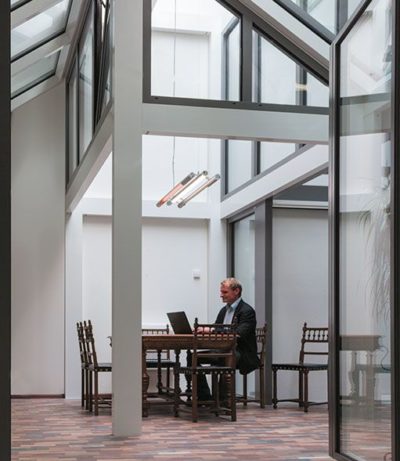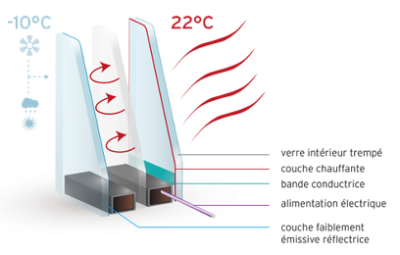Home / Heating / Infrared Heating / How to heat a veranda without consuming too much? (español – français)
Offer to your customers a heating solution for verandas that is efficient and adapted to their needs
Share this page
Veranda: the advantage of its constraints…
Verandas become very quickly warm and comfortable once the rays (infrared) of the sun reach (and pass through) their glazing. A perfect extension to relax… The problem is during the shoulder season or winter, when the number of hours of the sun is limited, it is difficult to rely only on the sun to heat that veranda.
What are the main issues related to heating the verandas?
- The energy losses (related to glass walls) that make, very often, an energy-consuming solution out of it. However, this is to weight as the heated veranda reduces the heating needs of the house (source SNFA – National Union for the Construction of windows, façades and associated activities).
- Mastering the room temperature complex to stabilise, both upwards and downwards (too hot, too cold).
What heating principle should be privileged to maximise the comfort and minimise the consumption?
In a classical veranda, which means with more than 3-4 glazed faces including the ceiling, it doesn’t make any sense to heat the whole volume. You should go for a principle of localised heating, at close proximity to the person to heat.

Picyures @ Degxel Uk
The main solutions to heat a veranda
Few adapted solutions to heat a veranda:
- The electric radiant heating: operating on the principle of sunlight, the heat emitter produces and distributes the infrared radiation.
- The homes: fireplaces, wood/pellets stoves, inserts: generate the heat both by radiation and convection heating the air.
- Extend the central heating of the house (if it exists and to the extent possible) to that room via a heater or an underfloor heating.
- Use a source of renewable energy specific to a veranda or common to your house.
- The heated glass for veranda.
1. The radiant heating (or infrared radiant)
The infrared heating (that we also call radiant) operates on the principle of the sun. It emits a radiation of infrared wavelength, based on electricity or gas that we burn.
It is necessary to distinguish 2 types of infrared heating:
- The FIR heating or Far Infrared. This one is not suitable to heat verandas since the heat needs to be accumulated in the walls, floor, ceiling before being restored at low temperature. In the case of veranda with 4 glazed façades, it makes no sense. Indeed the infrared (similar to sunlight) would pass through the glazed façades which is not the goal. Learn more about the far infrared heating otherwise very effective.
- The NIR heating o Near Infrared. This type of wavelength (near) is especially suited for complex areas to heat as verandas. Its range is about 2 to 3 meters maximum.
The advantages of the infrared heating in a veranda or glazed wall area
- The infrared heating produces a soft and comfortable heat, comparable to that of a wood stove.
- It is an almost ideal solution to heat this kind of glazed spaces or when the air movements are important. We do not heat unnecessarily areas that are almost impossible to heat! Even if the powers are high, in the end, as we heat only a localised area, the consumption can be limited.
- Depending on the models, the emission of heat can be almost instantaneous.
- Important for verandas: the infrared heating does not dry the air and does not create moisture.
It is particularly advantageous and suitable for the veranda and the floor to be well insulated (breakage of the thermal bridge, insulating glass)
This method of heating is to be directed towards the person to be heated and at a distance of 3 meters maximum, fixing accessories are provided for a ceiling mounting (rods, cables, etc.) or wall mounting (ball-and-socket joints, articulated rods, etc.) or on feet.
Learn more about NIR infrared heating.
2. Fireplaces, stoves, inserts

BATHYSCAFOCUS S/PIED @ www.focus-creation.com
The advantages of a wood heating within a veranda or a glazed wall area
- Low energy consumption, ecological.
- Relatively fast warm feeling.
Mixing the radiation and the convection, this heating mode is well suited for verandas.
The constraints are:
- The price reported to the size of the veranda – or even of the area – to heat. It is likely that the cost per m2 will be very high, except for ineffective rudimentary solutions.
- The size and the technical possibilities of the positioning (layout) and extraction (smoke duct).
- Fuel storage.
- The resulting moisture that can seep walls if the temperature difference between the outside and inside is important.
3. Heated glass for veranda

Vitrage chauffant CalorGlass® @ https://www.fillonneau.com
This is an electric surface heater that heats by radiation. A thin layer (integrated inside of the glass and invisible) composed of metallic micro-particles heats at low temperature (from 20°C to 40°C).
The advantages are:
- no condensation
- radiant heating towards the inside of the veranda (and limited towards the outside depending on the manufacturers).
- design: the supply and the cabling are hidden in the profiles.
There are still few operational feedbacks about this kind of solution.
Indications CalorGlass®: thermal performance of 250 W/m2, 4 m2 of heated glass can heat a veranda of 20 m2. That is 1000 Watts for 20 m2. Some retailers: Filloneau, Menuiseries de l’avenir, Riou Glass, Multi-Fermetures.
Learn more about the heated glass for veranda
FOX7


